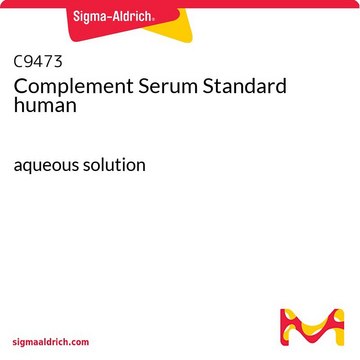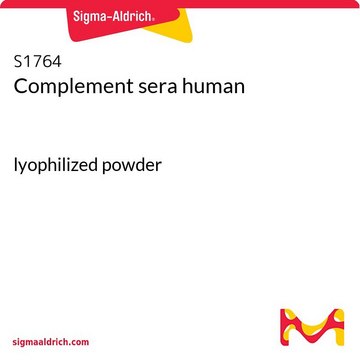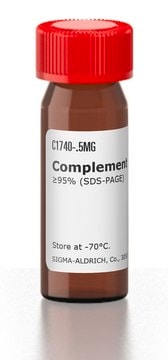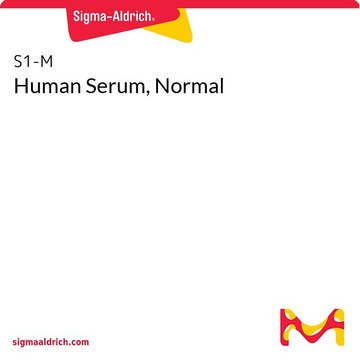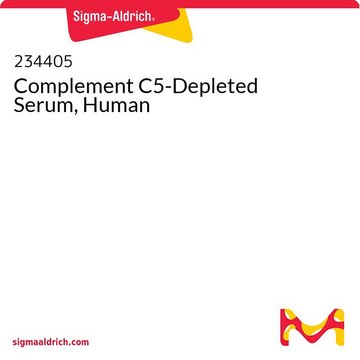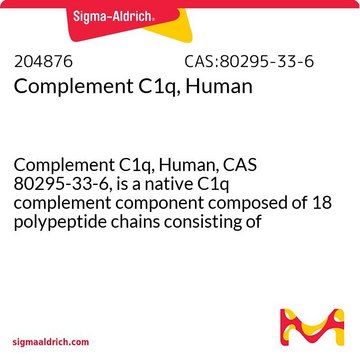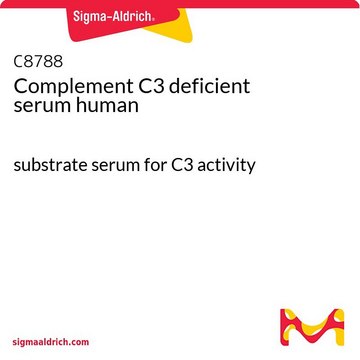234401
Complement C1q-Depleted Serum, Human
Synonym(s):
C1q-Depleted Serum, Human Complement Serum
About This Item
Recommended Products
form
solution
Quality Level
does not contain
preservative
manufacturer/tradename
Calbiochem®
storage condition
OK to freeze
avoid repeated freeze/thaw cycles
impurities
C1q, none detected (Ouchterlony using various dilutions of goat anti-human C1q antiserum.)
color
clear amber
shipped in
dry ice
storage temp.
−70°C
General description
Packaging
Warning
Unit Definition
Physical form
Preparation Note
Reconstitution
Other Notes
CLASSICAL PATHWAY ACTIVITY: One C1qH50 unit measured by classical pathway activation is defined as the amount of C1q required to yield 50% lysis of 3 x 107 EA when incubated in the presence of the recommended volume of C1q-Dpl for 30 minutes at 37°C in a total reaction volume of 500 μl GVB++.
• Recommended volume of C1q-Dpl serum per assay
• C1qH50 units/mg purified C1q at the recommended input of C1q-Dpl
• Input of purified C1q to yield 1 C1qH50:
• C1qH50 units/ml NHS Complement standard at the recommended input of C1q-Dpl
• Input of C1q in NHS Complement standard to yield 1 C1qH50
• Ratio
• Background A412 EA blank reading at the recommended input of C1q-Dpl
CH50 FUNCTIONAL ACTIVITY UPON RECONSTITUTION: One CH50 unit is defined as the input of C1q-Dpl, reconstituted with C1q, or NHS Complement Standard yielding 50% lysis of 1 x 108 EA when incubated for 60 minutes at 37°C in a total reaction volume of 1.5 ml GVB++.
• CH50/ml NHS Standard
• CH50/ml C1q-Dpl reconstituted with 100 μg C1q/ml:
• Ratio
ALTERNATIVE PATHWAY ACTIVITY: One unit of whole alternative pathway activity (APH50) is defined as the input of C1q-Dpl or NHS Complement Standard yielding 50% lysis of 1.5 x 107 rabbit erythrocytes when incubated for 30 minutes at 37°C in a total reaction volume of 75 ml GVB° containing a final Mg-EGTA concentration of 13.3 mM.
• APH50/ml NHS Standard
• Input of NHS Standard to yield 1 APH50
• APH50/ml C1q-Dpl
• Input of C1q-Dpl to yield 1 APH50
• AP Ratio
Legal Information
Storage Class
12 - Non Combustible Liquids
wgk_germany
nwg
flash_point_f
Not applicable
flash_point_c
Not applicable
Certificates of Analysis (COA)
Search for Certificates of Analysis (COA) by entering the products Lot/Batch Number. Lot and Batch Numbers can be found on a product’s label following the words ‘Lot’ or ‘Batch’.
Already Own This Product?
Find documentation for the products that you have recently purchased in the Document Library.
Our team of scientists has experience in all areas of research including Life Science, Material Science, Chemical Synthesis, Chromatography, Analytical and many others.
Contact Technical Service